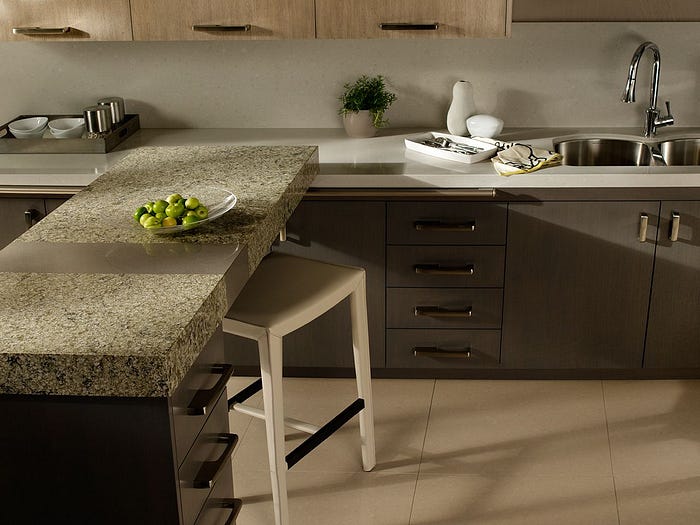
Quartz countertops have surged in popularity thanks to their durability, aesthetic appeal, and low-maintenance characteristics. However, the process of cutting quartz requires careful consideration, specialized tools, and precise techniques to achieve optimal results. In this comprehensive guide, we'll explore the step-by-step process of cutting quartz countertops, ensuring a smooth and precise outcome for your project.
Understanding Quartz Countertops
Quartz countertops are engineered surfaces composed of quartz crystals, resins, and pigments. This combination results in a durable and non-porous material that's resistant to scratches, stains, and heat. While quartz is known for its toughness, cutting it requires specific precautions due to its hardness and composition.
Tools and Materials Needed
Before you embark on cutting quartz countertops, gather the following tools and materials:
- Quartz Countertop: Ensure your countertop is clean, stable, and properly supported on a flat surface.
- Safety Gear: Wear protective eyewear, gloves, and a dust mask to safeguard against debris and quartz dust.
- Marker or Pencil: Use a marker or pencil to indicate the cutting line on the countertop surface.
- Masking Tape: Apply masking tape along the cutting line to minimize chipping and provide a visual guide for cutting.
- Circular Saw with Diamond Blade: Choose a high-quality circular saw fitted with a diamond-tipped blade designed for cutting quartz.
- Clamps: Secure the countertop in place using clamps to prevent movement during cutting.
- Supporting Material: Position a sacrificial board or plywood beneath the countertop to reduce splintering and protect the underlying surface.
Step-by-Step Cutting Process
Follow these steps to cut quartz countertops safely and accurately:
Step 1: Measure and Mark the Cutting Line
Use a tape measure and straight edge to determine the precise cutting dimensions on the quartz surface. Mark the cutting line with a marker or pencil, ensuring accuracy and clarity in your measurements.
Step 2: Apply Masking Tape
To safeguard against chipping and provide a cutting guide, apply strips of masking tape along both sides of the marked cutting line. The tape acts as a protective barrier and helps maintain a clean edge during cutting.
Step 3: Secure the Countertop
Place the quartz countertop on a stable work surface, such as sawhorses or a workbench, ensuring it's well-supported and level. Use clamps to secure the countertop in position, minimizing any potential movement during the cutting process.
Step 4: Prepare the Circular Saw
Attach the diamond-tipped blade to your circular saw, ensuring it's securely fastened and compatible with cutting quartz. Adjust the saw's cutting depth to penetrate the quartz material without cutting too deeply, which could damage the countertop surface.
Step 5: Make the Cut
With all preparations complete, carefully guide the circular saw along the marked cutting line, maintaining steady pressure and a consistent speed. Allow the saw blade to smoothly penetrate the quartz material, avoiding abrupt movements that may cause chipping or uneven cuts.
Step 6: Review and Refine
Once the initial cut is complete, evaluate the quality of the cut edge for any imperfections or roughness. If necessary, use a fine-grit sandpaper or diamond polishing pad to refine the cut edge and achieve a smooth finish.
Step 7: Clean and Inspect
Remove the masking tape and thoroughly clean the countertop surface to remove any dust or debris generated during cutting. Inspect the cut edge for accuracy and smoothness, making any final adjustments as needed to ensure a flawless result.
Safety Precautions
When cutting quartz countertops, prioritize safety by adhering to these essential precautions:
- Wear appropriate safety gear, including goggles, gloves, and a dust mask, to protect against injuries and airborne particles.
- Ensure proper ventilation in your work area to minimize exposure to quartz dust, which can be harmful if inhaled.
- Use caution when handling power tools, maintaining a firm grip and steady control throughout the cutting process.
- Keep bystanders at a safe distance from the cutting area to prevent accidents or injuries.
Conclusion
Cutting quartz countertops requires careful planning, precise measurements, and the use of specialized tools and techniques. By following the step-by-step process outlined in this guide and prioritizing safety at every stage, you can achieve clean, accurate cuts that enhance the beauty and functionality of your quartz surfaces. Whether you're installing a new countertop or making custom modifications, mastering the art of cutting quartz will unlock endless possibilities for your home improvement projects
3.5